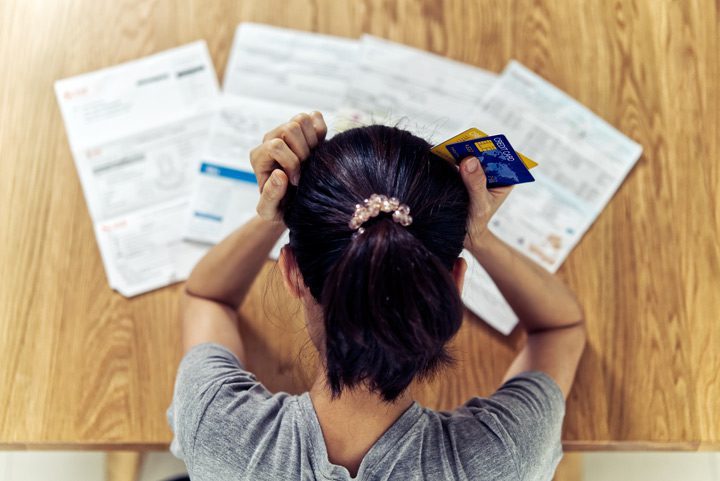
Americans love to shop.
In 2018, overall retail spending in the United States exceeded $3.6 trillion. Retail e-commerce purchases in America totaled $517.36 billion—more than any other country. In addition, more people use smartphones to shop rather than laptops/desktops than ever before because of convenience—46 percent of online shopping orders are placed with phones.*
There’s something to be said about consumer confidence, and in what ways that might contribute to a thriving economy. But our individual financial responsibility requires good money management, not overspending beyond what we can afford, and recognizing the difference between “need” items and “want” items.
To fulfill shopping desires, people often get into credit card debt, borrow or even steal money from friends and relatives, or sacrifice necessities. Another troubling aspect is how many people choose not to engage with anyone else and simply click a few times to fill a cart. Every major retailer—online and brick and mortar stores—offers a shopping app. If nearly half of all online purchases are made with smartphones, it’s obviously too easy to buy something without weighing the true need for it or going to any effort to obtain it.
Compulsive Shopping as an Addiction
Buying without mindfulness is often triggered by emotional distress, avoidance of key issues, and an urge to participate in the activity. Impulsive spenders or compulsive shoppers suffer from a process addiction.
This disorder is referred to as an addiction because brain chemistry changes based on how the reward center reacts to the action of shopping. The brain continues to associate the behavior with pleasure, releasing dopamine. Then, the brain becomes reliant on that boost, which prompts urge-based behavior in the form of shopping, gambling, gaming, sex, binge-eating, and other compulsive behaviors.
This is what happens with substance abuse, too. Harvard Medical School researchers note that “addictive substances and behaviors stimulate the same circuit—and then overload it.”
Mental Health America (MHA) defines oniomania, or compulsive shopping, as: “an uncontrollable desire to shop which results in spending large amounts of time and money on the activity. Generally a person who buys compulsively gets the urge to shop in response to negative emotions (not to be confused with occasional “retail therapy”) and often has problems with relationships and finances as a result of their shopping behavior.”
MHA indicates there are four stages of compulsive buying.
- Anticipation: Thoughts and urges start. They may focus on a specific item or the act of shopping itself.
- Preparation: Research and decision-making take place. A person may look into sales or debate about where to go shopping.
- Shopping: Shopping happens. This is the so-called “thrill of the hunt.” The person gets a “high” while doing it.
- Spending: Something, or many things, are purchased. The person is sad that the shopping experience is over and may be disappointed afterwards about how much they’ve spent.
MHA also notes people with compulsive shopping behavior frequently have co-occurring disorders such as anxiety, depression, eating issues, PTSD and other trauma, and substance abuse. Excessive spending is also one warning sign of borderline personality disorder.
Do You Have a Compulsive Shopping Problem?
Statistics indicate that nearly six percent of Americans will suffer from compulsive shopping disorder at some point in their lives. Additionally, about 60 percent of individuals with hoarding issues often have a problem with compulsive buying.
Remember, the urge to overspend or buy more than necessary has less to do with the items and more to do with underlying factors. There are some essential questions to answer if you believe you or someone you love has a compulsive shopping problem:
- Do you regularly “binge shop?”
- Does shopping boost your mood, or do you use the activity as a way to handle stress or avoid negative emotions?
- Do you feel a strong urge to go shopping, or anxious when you can’t go?
- Are there times when you feel ashamed, guilty, or more stressed or disappointed after buying things?
- Do you often feel out of control while shopping?
- Are you concerned that other people will pass judgment on you if they knew how much you shop?
- Do you often hide your purchases from others?
- Are you experiencing or do you frequently experience financial trouble because of your shopping?
- Are you in credit card debt due to overspending?
Responding “yes” to two or more questions indicates there may be reason for concern.
One way to understand how this disorder affects people is to attend a 12-Step group such as Spenders Anonymous and, if the behavior has caused financial difficulty, Debtors Anonymous. These are supportive communities that provide a non-judgmental atmosphere.
However, actually treating a shopping addiction requires professional help.
What Cottonwood Tucson Can Do
Treatment for impulse spending and buying starts with uncovering the reasons for the behavior. Too often, a person might be on auto-pilot, and using shopping as a means to mask true pain.
The expert staff of Cottonwood Tucson uses techniques such as cognitive behavioral therapy paired with mind/body modalities to help individuals with spending urges learn what triggers the behavior. Then, patients develop new coping methods to manage negative emotions more effectively. Finally, clinicians create an aftercare plan that includes a personal spending recovery support system and a relapse prevention plan.
If you or a loved one needs this type of dedicated care, reach out to us right away.
*Source: U.S. Shopping Statistics







